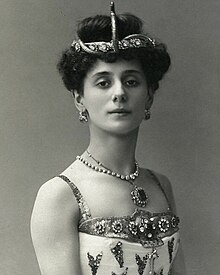Anna Pavlova

- Anna Pavlova is also the name of an Olympic gymnast. See Anna Pavlova (gymnast).
Anna Pavlovna Pavlova (Анна Павловна Павлова) (31 January 1881 (Old Style)/12 February 1881 (New Style) - 23 January 1931) was a famous ballet dancer of the early 20th century.
Pavlova was born in St. Petersburg, Russia two months pre-mature. She later claimed her father had died when she was two years old. She was rejected at the age of eight from the Imperial Ballet School because she was too small for her age and was asked to return when she reached her 10th year. At age 10 she entered the school, and in April of 1891 danced in her very first perfromance as a cupid in Marius Petipa's A Fairy Tale. She trained under some of the greatest teachers of the day - Christian Johansson, Pavel Gerdt, Nikolai Legat, and the great Ballerina Ekaterina Vazem (creator of the role of Nikiya in La Bayadère), and graduated in 1899 at age 16, being allowed to enter the Imperial Ballet a rank ahead of corps de ballet as a coryphée. She rose through the ranks quickly, as she was a favorite of the old Maestro Petipa - second soloist in 1902, Première Danseuse in 1905, and finally Prima Ballerina in 1906 after a resounding performance in Giselle, for which Petipa revised the Ballerina's dances espcially for her (they are still performanced today in this version at the Mariinsky). She was much celebrated by the fanatical balletomanes of Tsarist St. Petersurg. Her legions of fans called themselves the "Pavlovtzi"
Pavlova forever changed the ideal for ballerinas. In the 1890s, ballerinas at the Mariinsky Theatre were expected to be strong technicians, and this usually meant a strong, muscular, compact body. Pavlova was thin, delicate-looking, and ethereal, perfect for romantic roles such as Giselle. Her feet were extremely arched, so she strengthened her pointe shoe by adding a piece of hard leather on the soles for support and flattening the box of the shoe. At the time, many considered this "cheating." But this became the modern pointe shoe, as pointe work became less painful and easier for arched feet.
In the first years of the Ballets Russes she worked briefly for Serge Diaghilev. Originally she was to dance the lead in Mikhail Fokine's The Firebird, but refused the part, as she couls not come to terms with Stravinsky's score (the role went to Tamara Karsavina. By the mid 1900s she founded her own company and performed throughout the world.
Her most famous showpiece was The Dying Swan choreographed for her by Michel Fokine, danced to The Swan from Carnival of the Animals by Camille Saint-Saëns.
She died of pleurisy in The Hague, Netherlands while touring, a few days or weeks before her 50th birthday. Her last request was to hold her costume from The Swan, and her last words were "Play that last measure very softly". In accordance with ballet tradition, on the day she was to have next performed, the show went on as scheduled, with a single spotlight circling an empty stage where the dancer would have been. She was cremated, and services were held in a Russian Orthodox church in London before burial in Golders Green Cemetery in London. Her remains were moved in 2001 to the Novodevichy Cemetery in Moscow in accordance with her requests and after considerable controversy [1].
The Pavlova dessert was named after her, although its origins are disputed. Both New Zealand and Australia have claimed the credit.
Ruth St. Denis, a popular modern dancer said "Pavlova lived on the threshold of heaven and earth as an interpreter of the ways of God". [citation needed]
